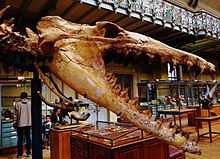Cynthiacetus
| Cynthiacetus Temporal range: Late Eocene | |
|---|---|
 | |
| Skull of C. peruvianus at the MNHN, Paris | |
| Scientific classification | |
| Kingdom: | Animalia |
| Phylum: | Chordata |
| Class: | Mammalia |
| Order: | Cetacea |
| Suborder: | †Archaeoceti |
| Family: | †Basilosauridae |
| Genus: | †Cynthiacetus Uhen 2005 |
| Species | |
| |
Cynthiacetus is an extinct genus of basilosaurid early whale that lived during the Upper Eocene (Bartonian-Priabonian, 40.4 to 33.9 million years ago.)[1] Specimens has been found in the south-eastern United States, Egypt and Peru.[2]

The skull of Cynthiacetus was similar in size and morphology to that of Basilosaurus, but Cynthiacetus lacked the elongated vertebrae of Basilosaurus. Uhen 2005 erected the genus to avoid the nomen dubium Pontogeneus (which was based on poorly described and now vanished specimens).[3] Cynthiacetus was smaller than Masracetus.[4]
The South American species C. peruvianus, the first archaeocete to be described on that continent, mainly differs from C. maxwelli in the number of cuspids in the lower premolars, but is also has the greatest numbers of thoracic vertebrae (20).[2]
Notes
References
- Gingerich, Philip D (2007). "Stromerius nidensis, new archaeocete (Mammalia, Cetacea) from the Upper Eocene Qasr El-Sagha Formation, Fayum, Egypt". Contributions from the Museum of Paleontology 31 (13): 363–78. OCLC 214233870.
- Martínez-Cáceres, Manuel; Muizon, Christian, de (2011). "A new basilosaurid (Cetacea, Pelagiceti) from the Late Eocene to Early Oligocene Otuma Formation of Peru". Comptes Rendus Palevol 10: 517–26. doi:10.1016/j.crpv.2011.03.006. OCLC 802202947.
- Uhen, Mark D. (2005). "A new genus and species of archaeocete whale from Mississippi". Southeastern Geology 43 (3): 157–72.
- Uhen, Mark D. (2008). "Basilosaurids". In Perrin, William F.; Wursig, Bernd; J.; Thewissen, J.G.M. Encyclopedia of Marine Mammals (2 ed.). Academic Press. pp. 91–4. ISBN 978-0-12-373553-9.
| Wikimedia Commons has media related to Synthiacetus. |
| |||||||||||||||||||||||||||||||||||||||